Jezebel’s Death
“And it shall come to pass, that him that escapeth the sword of Hazael shall Jehu slay: and him that escapeth from the sword of Jehu shall Elisha slay” (1 Kings 19:17).
Revelation names only four historical persons: faithful Moses, faithful David, iniquitous Balaam and but one woman – iniquitous Jezebel. In itself, the name “Jezebel” holds the promise of noble character and one derivation suggests the meaning “without co-habitation.” By interpretation this means “chaste,” and were Bible translators trying to convey the richness of Biblical names they might well translate “Jezebel” as “Chastity.”1 Yet, “Jezebel” has come to stand for the embodiment of the dangers for God’s people in foreign alliances, abominable idolatry, unbridled ambition, and wickedness in power.
From the deeply symbolical language of Revelation 2:20 we find that the significance of Jezebel goes well beyond the general instructive lessons of history. From the use in Revelation we stand on firm ground when we recognize Jezebel as a type. Much has been written about her conduct towards the worship of God and actions in life, but our insights into the type will be deeper if we focus on the circumstances of her death, and those complicit in her death. The significance of Elijah, Ahab and Jezebel in prophecy is well-defined in the Harvest message.
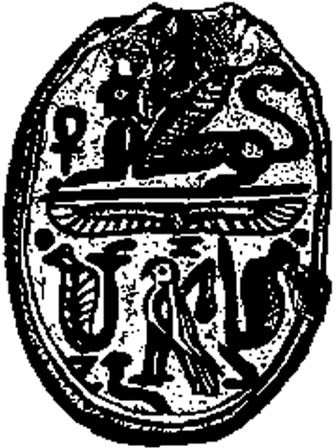
Egyptian style seal believed to belong to Queen Jezebel
“Elijah’s prophecy was larger than on the surface appeared; for he and all of his doings were a type on a small scale of greater things which came afterwards. Elijah was a type of the Church in the flesh … [this] is confirmed to us by certain statements in the Revelation. The matter is there covertly presented, a great religious system being figuratively described as Jezebel, and the worldly system to which this professed Church of Christ is united being represented by Ahab, the king of Israel” (Reprint 5741).
OMRI’S HOUSE
The political forces of her day should be considered across several generations. Here we will follow sin and error across four generations to its destruction. We will also consider the linkages with Elijah and Elisha and the two battles at Megiddo that open and close the history of this period.
The first battle at Megiddo took place five years into the reign of Solomon’s successor Rehoboam. The city that Solomon fortified at Megiddo was captured by Pharaoh Shishak (possibly Shoshenq I) as part of a successful Egyptian campaign to Syria-Palestine. We find this both in the books of 1 Kings 14:25 and 2 Chronicles 12:2.2,3 Shishak seems not to have destroyed this city. Rather, he erected a victory monument, something usually done only in cities that the Egyptians subsequently occupied. There is no evidence for a lengthy occupation.4 The land of blessed promise was not now to know peace.
Civil war further polarized the twelve tribes descended from Jacob. They formed into a nation of ten-tribes called “Israel” with its capital in Samaria; and a two-tribe nation of “Judah” which followed David’s House from its power base in Jerusalem. In the forty-six years following Solomon we can count two disgraceful attempts to establish dynasties in the breakaway ten-tribe kingdom.
The first break with David’s house was led by Jeroboam and began with the Lord’s blessing through the prophet Ahijah (1 Kings 11:29-31). The rebellion against Solomon’s sadly unwise son Rehoboam, whose mother “the Ammonite” was one of Solomon’s foreign wives. Because of Jeroboam’s sins, this kingly line ended in the destruction of Jeroboam’s house down to the “remnant” (1 Kings 14:10).
The second attempt to establish the throne of the ten-tribe kingdom was by Baasha (1 Kings 15:26-28). Baasha himself succeeded to the throne by means of assassination and “they who sow the winds reap the whirlwinds.” Baasha’s son Elah, his immediate successor, was in turn assassinated while he was drunk, thus ending the second attempt at dynasty-building.
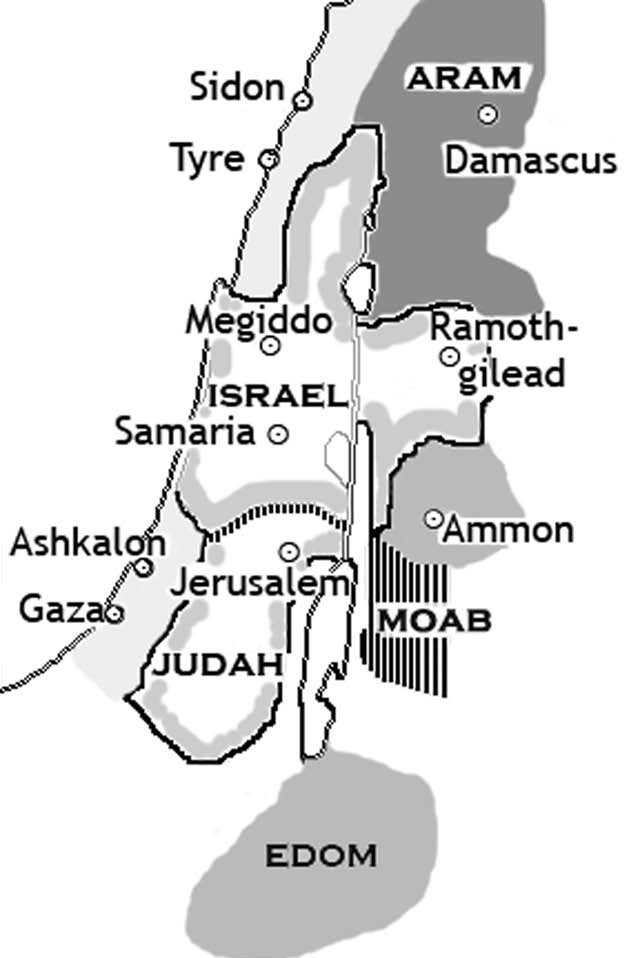
Political map of Ahab and Jezebel’s period (9th century BC.)
From the strife that followed in Israel Omri eventually emerged as the new power. He founded what was now the third dynasty to rule the ten-tribe breakaway kingdom. Despite the unpromising start, he had the legitimacy of popular support from the army who elected him their leader (1 Kings 16:16). Omri exhibited great energy during his reign, yet he is noted in the scriptural record as one who “wrought evil in the eyes of the LORD, and did worse than all that were before him” (1 Kings 16:25).
Some archeologists believe there is evidence that Omri and Ahab showed great energy for building projects. Megiddo was rebuilt and greatly enhanced through the enthusiastic support of Omri and his son Ahab. Perhaps they were responsible for digging the famous water tunnel and constructing the so called “stables.” Jezreel became an auxiliary residence for these kings and grew in importance, becoming second only to the state capital at Samaria.
There were abortive hopes that the kingdoms of Israel and Judah might reunite as a successor to the United Monarchy of David and Solomon. Omri then made what would prove to be an ultimately destructive decision to consolidate an alliance with the economic powerhouse of Sidon. It was Omri who would have arranged for the marriage of Ahab to Jezebel, daughter of the Phoenician king Ethbaal of Sidon.
This was a decision that would result in the annihilation of his house and the near annihilation of the ruling line of David. During the rule of Omri’s dynasty, the histories of Israel and Judah were intertwined. Israel and Judah intermarried. Israel and Judah shared princely names. Because of these complexities, some of the key family relations are shown displayed according to their generations. Despite these relationships, a true reconciliation proved elusive and the two kingdoms remained separate entities until Israel was conquered by the Assyrians in 723 BC and Judah by the Babylonians in 606 BC.
AHAB’S RULE
Ahab far exceeded his father in doing evil. His permission and participation in Baal worship was so abominable that the prophet Elijah confronted him and prophesied the punishment of what proved to be a catastrophic drought in Israel (1 Kings 17:1). Again, we have the authority of Revelation to recognize this drought period as a type.
Reprehensible as Baal worship was, it appears that Baal worship was not the ground for Ahab’s death sentence. Elijah laid a death sentence on Ahab and his descendants in retribution for the death of Naboth, a prominent member of a wealthy Jezreelite family. According to 1 Kings 21, Ahab desired the vineyard that Naboth possessed outside the city of Jezreel, but Naboth refused to give it up. Queen Jezebel proceeded to have Naboth falsely accused of blasphemy, put on trial, and then stoned to death outside the city. This death sentence apparently also included Naboth’s sons (2 Kings 9:26). Jezebel and Ahab then seized the vineyard Ahab so greatly desired. God was angry and sent Elijah to the field of Naboth to speak to Ahab, to tell him he had slain the true owner of that field unjustly. Elijah prophesied that in the very place where the dead body of Naboth was eaten by dogs both his own blood and that of his wife would be shed. Further he prophesied that all Ahab’s male heirs would perish.
The Lord is gracious to the repentant, yet just. Ahab repented of his sins, confessed them, put on sackcloth, went barefoot and refused to touch any food. This endeavor to appease God had some limited success. Ahab’s remorse for the crime instigated by Jezebel apparently was sincere. The Lord again spoke to Elijah instructing him that while Ahab was living he would defer the punishment of his family. Nevertheless, Ahab was promised that God still would fulfill his sentence upon Ahab’s descendants.
The 22-year reign of Ahab ended with his death from wounds in battle with the Syrians (Aramites). This battle did not take place at Megiddo, but rather at Ramoth-Gilead, a Levitical city which Solomon had established as a district capital city. Ramoth-Gilead is located across the Jordan River from the Jezreel Valley, 50 miles directly east of Megiddo (1 Kings 22:29). His chariot was returned to Jezreel for cleaning and Ahab’s blood was licked up by the dogs. All was in fulfilment of God’s judgment as prophesied by Elijah (1 Kings 22:37-38).
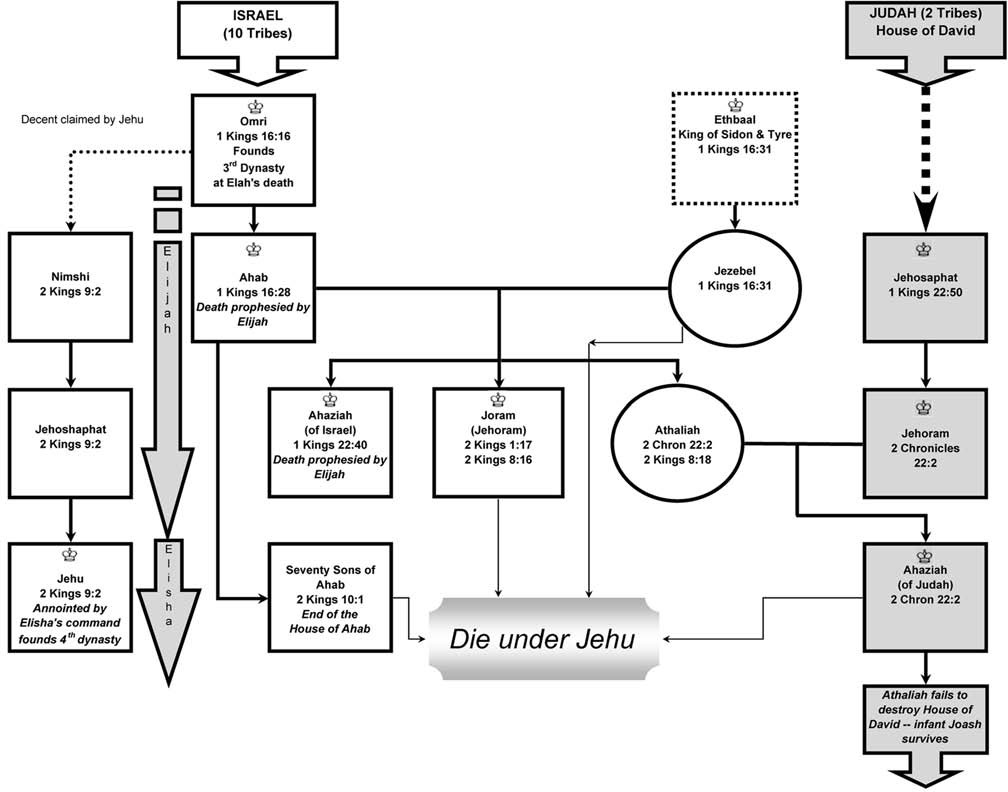
Generational relationships among Israel, Judah, Jehu, Elijah and Elisha.
AHAZIAH’S RULE
Ahaziah was the first of Ahab’s two sons to follow his father to the throne. His brief reign for portions of two-years added yet more abominations to those introduced by Omri and Ahab. An accidental fall through what is believed to be a lattice-work window left Ahaziah mortally injured. He decided to send to Ekron, a principal city of the Philistines, to enquire about his recovery directly of the god “Baal-zebub” (or “Beelzebub” in the New Testament).
Directly translating this name, it means the “Lord of the flies.” However, it was a custom of the Hebrews to slur the name of false gods by changing them to something similar but degrading. Quite possibly, the ending “zebub” may be an alliteration of one of the titles of Baal shown in the Ras Shamra texts as “Zebul” (“Prince”). “Beelzebub” is a “prince” indeed, the very prince of devils according to the testimony of the Pharisees (Matthew 12:24). Once again, Elijah directly proclaimed Jehovah’s judgment and prophesied the death of a King of Israel. Ahaziah never recovered and died of his injuries (2 Kings 1:1-17).
JORAM’S REIGN
Following Ahaziah’s death, his brother Jehoram (Joram) succeeded to the throne of Israel and relative peace ensued during his 12 year reign (2 Kings 3:1). Some modest reforms took place. The idol of Baal that Ahab had set up was “put away” by Joram, although it is telling that there is no record of it being destroyed (2 Kings 3:2). Elijah the prophet passed from the scene during the reign of Joram King of Israel to be succeeded by Elisha.
During the ministry of Elisha the relative calm from military strife was broken. It was then that Joram, king of Israel, and his mother Jezebel, met their much-deserved deaths. In another battle at Ramoth-gilead, Joram led Israel against against the Syrians (Aram). His foe was King Hazael, Hazael to whom the prophecy opening this article refers.
Joram was wounded severely and taken from the battlefield. He was brought to Jezreel to recover in relative peace. This peaceful recovery was not to happen. A chain of events leading to his death, Jezebel’s death, and a multitude of other deaths, appears in the following map (after Cline, op. cit.)
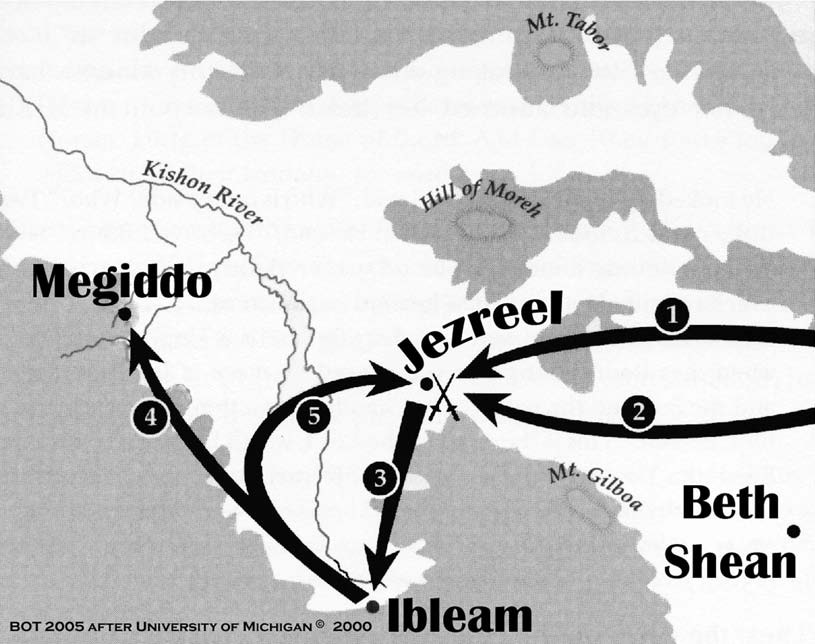
Jehu, Joram and Ahaziah. (1) Joram goes to Jezreel from Ramoth-Gilead to recup- erate, Ahaziah follows. (2) Jehu rides to Jezreel from Ramoth-Gilead. (3) Joram is killed at Jezreel, Ahaziah flees but is mortally wounded near Ibleam. (4) Ahaziah reaches Megiddo, where he dies. (5) Jehu returns to Jezreel and kills Jezebel.
Ahaziah, king of Judah and himself the nephew of Joram, came to Jezreel to visit Joram during his convalescence (2 Kings 9:14-16, 2 Chronicles 22:5-7). Unknown to any but his closest comrades, Jehu, a commander in King Joram’s army, was approached by a servant of Elisha who anointed him king and entrusted him with a special charge to destroy the remnants of Ahab’s house (2 Kings 9:1-14). From modern archeology we learn that Jehu may actually have been more than a mere army commander, for he is described in Assyrian records as being a member of the House of Omri. He thus may have been a relative of Joram and the royal family. This would explain his high military office.
Jehu rode quickly to Jezreel before the news of the coup d’etat became generally known. Jehu’s characteristic reckless chariot driving betrayed his identity to the guards watching from the gate long before he arrived at the city. Joram and Ahaziah must have entertained great interest in what this approach by Jehu meant. They had time to mount their chariots and proceed outside the city, where they met Jehu – and their deaths – again in Naboth’s vineyard.
When Joram saw Jehu, he said, “Is it peace, Jehu?” Jehu answered, “What peace can there be, so long as the many whoredoms and sorceries of your mother Jezebel continue?” Then Joram reined about and fled, saying to Ahaziah, “Treason, Ahaziah!” Jehu drew his bow with all his strength, and shot Joram between the shoulders, so that the arrow pierced his heart. Joram sank in his chariot. Jehu said to his aide Bidkar, “Lift him out, and throw him on the plot of ground belonging to Naboth the Jezreelite; for remember, when you and I rode side by side behind his father Ahab how the Lord uttered this oracle against him: ‘For the blood of Naboth and for the blood of his children that I saw yesterday, says the Lord, I swear I will repay you on this very plot of ground.’ Now therefore lift him out and throw him on the plot of ground, in accordance with the word of the LORD” (2 Kings 9:22-26).
Ahaziah seems to have been an unfortunate, although perhaps not so innocent, bystander who was caught up and killed in this coup. The account in 2 Chronicles claims that he had in fact been allied with Joram against King Hazael of Aram and had been present at the battle at Ramoth-Gilead when Joram was wounded. According to the account in 2 Kings, upon seeing Joram cut down by Jehu, Ahaziah tried to flee in the direction of Beth-Haggan, toward modern Jenin. According to this account, either Jehu himself or Jehu’s men pursued Ahaziah and shot him by the town of Ibleam, but were unable to capture him. Ahaziah changed direction and made it as far as Megiddo where he died. His body was subsequently taken to Jerusalem and buried there in a tomb with his ancestors (2 Kings 9:27-28). At the same time, forty-two of Ahaziah’s relatives, who were on their way to visit him at Jezreel, also perished at Jehu’s hand (2 Kings 10:13-14).
At first, the death of king Ahaziah of Judah might seem an excessive exercise in bloodshed. This we learn was the Lord’s perspective (Hosea 1:4). Yet, intoxicated with worldly power and politics, Jehu apparently persuaded himself that there was a compelling reason for the bloodshed. Examining the diagram of family relations, we see that Joram of Israel was the maternal uncle of Ahaziah of Judah. In cultures that tolerate polygamy we need to recognize that the natural tendency of a male child is not toward his father as it properly should be according to the divine arrangement. Rather, the chief male figure of consequence for a son is actually the eldest brother of the mother – the maternal uncle. Ahaziah was supporting his maternal uncle in battle.
JEZEBEL DIES
Following the deaths of Joram and Ahaziah, Jehu turned his attention to Jezebel, widow of Ahab, mother of Joram, daughter of the Phoenician king Ethbaal of Sidon, the queen mother in Israel. She was not only blamed for orchestrating the unjust death of Naboth for the sake of his vineyard but Jehu now sought to stir up religious zeal against Jezebel for worshiping Baal. Entering the city of Jezreel, Jehu saw Jezebel waiting for him. She was looking out of a second story window. Though Jezebel clearly was past the flower of her youth, the Bible records the detail that like a fading actress, she painted her eyes and had her head adorned.
The account in 2 Kings relates her end as follows. Jehu looked up to the window and said, “Who is on my side? Who?” Two or three eunuchs looked down at him. He said, “Throw her down!” So they threw her down; some of her blood spattered the wall and on the horses, which trampled on her. Then Jehu went in and ate and drank. He said, “See to that cursed woman and bury her; for she is a king’s daughter.” But when they went to bury her, they found no more of her than the skull and the feet and the palms of her hands. When they came back and told him, he said, “This is the word of the Lord, which he spoke by his servant Elijah the Tishbite, In the territory of Jezreel the dogs shall eat the flesh of Jezebel; the corpse of Jezebel shall be like dung on the field in the territory of Jezreel, so that no one can say, This is Jezebel” (2 Kings 9:32-37).
Some seventy additional descendants of Ahab were also slain during Jehu’s coup (2 Kings 10:1-14). Yet here, there is an indication of the Lord’s grace. Counting out the years between Ahab’s death and Jehu’s coup we find there is a period of approximately 14 years. We ask, “Knowing how gracious the Lord is, had there been even one son of Ahab born posthumously and had that son made a decision to uphold the righteousness of the law and had he further signified this with a barmitzvah at age 13, might this son have been delivered from judgment?” Following the beheading of the seventy sons of Ahab in Samaria, Jehu ordered the severed heads sent to him and had them stacked in two piles outside the city gates of Jezreel as a grisly testimony to the fruition of the curse on the House of Ahab.
ATHALIAH’S TREACHERY
The deaths of Joram, Ahaziah and Jezebel opened a door of opportunity that only the most inhuman of those who feed on power in this world would dare to pass through. Ahaziah’s mother was Athaliah, the daughter of Ahab and Jezebel (2 Chronicles 22:2, 2 Kings 8:18). Upon learning of her son’s death, Athaliah now proved that she could exceed even her mother Jezebel in brutal and treacherous conduct, for “she arose and destroyed all the royal seed” (2 Kings 11:1). In the midst of all the mayhem in the royal compound her sister-in-law Jehosheba managed to hide Joash, an infant-in-arms of the royal line (2 Kings 11:2). Both Joash and his nurse found refuge in the temple of Jehovah where Athaliah had only enemies and was certain not to resort for worship. Thus, by providential overruling, the line of David was not totally annihilated.
ARCHEOLOGICAL CONFIRMATION
Recent archaeological discoveries may shed additional light on the story of Jehu’s rebellion and on the death of Joram and Ahaziah. Three fragments of an Old Aramaic inscription discovered at Tel Dan in 1993 and 1994 have been attributed to a stele of King Hazael of Aram.5 Hazael had usurped the throne of Aram only a short time before Jehu’s revolt, and was the very same king against whom Joram (and perhaps Ahaziah as well) was fighting when he received the wound that caused him to retreat to Jezreel. If the restoration and translation of the inscription on this stele are correct, Hazael claims that he, not Jehu, killed Joram and Ahaziah, thus shedding an interesting light on the whole matter. While boasting and exaggeration are the stock and trade of all despots not under the scrutiny of a free press, this obviously untrue claim in conflict with the scriptural testimony of 2 Kings 9:24, 27 could have some legitimacy if Hazael considered Jehu a vassal serving him. The text reads as follows:
“And Hadad went in front of me, and I departed from … my kingdom, and I slew mighty kings, who harnessed thousands of chariots and thousands of chariot horses. I killed Joram … son of Ahab, king of Israel, and I killed Ahaziahu son of Joram, king of the House of David. And I set their towns into ruins and turned their land into desolation …” 6
The verse in 1 Kings cited at the opening of this article might help resolve the apparent contradiction between the sacred record and Hadad’s boasting, for it implies that under divine guidance the two men were probably working together. Then the Lord said to Elijah, “Go, return on your way to the wilderness of Damascus; when you arrive, you shall anoint Hazael as king over Aram. Also you shall anoint Jehu son of Nimshi as king over Israel. Whoever escapes from the sword of Hazael, Jehu shall kill” (1 Kings 19:15-17).
Historians suggest that Jehu would not have staged his revolt without the implicit consent of his Aramean opponent Hazael in the battle at Ramoth-Gilead. Without such complicity, Jehu might not have left the battle field with the assurance of safety for his troops so that he could drive his chariot to Jezreel to slay Joram and Ahaziah. It therefore also seems a distinct possibility that Jehu’s subsequent rule over Israel may have been as a vassal of, or at least an ally of, King Hazael of Aram.
The evidence is conjectural. The fiery destruction recorded at the site of Jezreel by the modern excavators and assigned by them to Jehu’s coup might instead be from its subsequent capture and conquest by Hazael. Recently it has been suggested that the destructions noted at a series of sites in the Jezreel Valley, including Megiddo, Tanach, Yoqneam and Jezreel, might be assigned to Hazael’s victorious campaign against the Israelites. At least one of the current excavators of Megiddo agrees that this is a distinct possibility, but the hypothesis remains to be fully explored.
Upon seizing the throne of Israel, Jehu probably had to deal with Hazael of Aram and was also immediately faced with an invasion by the dreaded Neo-Assyrians, led by King Shalmaneser III. This was already Shalmaneser’s fifth campaign to the West from his homelands in Mesopotamia, which means that Jehu’s reign was from its start marked by trouble.
The Assyrian campaign is recorded on the so-called “Black Obelisk.” This is an inscribed limestone stele that stood about six and a half feet high and was discovered by Austen Henry Layard at Nimrud (on the Tigris River in modern Iraq) in 1846. On one of the panels Jehu is shown prostrating himself with his forehead to the ground in front of Shalmaneser. The four beardless attendants are eunuchs. The accompanying inscription reads: “Tribute of Iaua [Jehu], son of Omri. Silver, gold, a golden bowl, a golden beaker, golden goblets, pitchers of gold, tin, staves for the hand of the king, and javelins, I [Shalmaneser] received from him.”
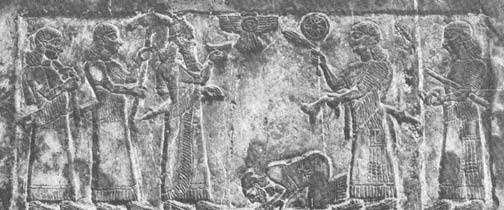
Jehu paying tribute to Shalmaneser of Assyria.
There is no mention in the Bible of Jehu paying tribute to Shalmaneser, but three additional Assyrian inscriptions also refer to “Jehu, son of Omri,” and imply that Jehu and his descendants became loyal vassals following the successful Assyrian campaign. Thus, the setting aside of the divinely laid out guidelines for conduct in the affairs of Jehovah’s special people led to the humiliating consequences we see so graphically portrayed.
CLOSING THOUGHTS
As free moral agents we have the capacity to do well or do wickedly, though never to do sinlessly. History from God’s perspective is not governed by a predestined set of actions. Human actions of individuals are not fated by divine will.
We find that the Bible contains not one, but both accounts of the intertwined histories of Judah and Israel in the books of Kings and Chronicles. These are included that we may be “thoroughly furnished.” A wise saying observes that, “History is philosophy teaching by example [or types], and also warning. Its two eyes are geography and chronology.”7
Our responsibility as we consider the lessons of sacred scripture is to reflect on the deeper lessons in the types that the Lord has set for our consideration. We have acknowledged, but not treated these types. Interpreting them should be a matter of cautious and playful consideration. Israel and Judah could have written a much different history had they and their rulers been obedient to the divine principles laid down in scripture. And so for us, while it is yet day, none of us has finished writing our individual histories as we run for the prize of the high calling. As heirs with Christ Jesus, let our individual histories be written with triumph.
– Richard Doctor
(1) Tregelles, S. (translator), Gesenius’ Hebrew and Chaldee Lexicon, (S.348), Baker, Grand Rapids (1979). There never seems to be complete agreement among scholars, so it may be judicious to add that there are alternate views, including a reasonable suggestion that the last portion of her name may derive from the idol Baal. In this case “exalted by Baal” is a possible and reasonable etymology. A highly unlikely derivation gives “Jezebel” the meaning of “unchaste,” formed from the word “not” (Iz) and “married” (baali) – this would not be the name a king would give his daughter.
(2) “Solomon’s Splendor Affirmed,” Beauties of the Truth (15,4) November 2004.
(3) That Shishak was Shoshenq is prevailing opinion among Egyptologists, but it is strongly challenged within the scholarly community when they observe that Egyptian history must be abbreviated if it is to accord with the Hebrew Old Testament (which is true). Hence this is not a completely settled issue.
(4) Cline, Eric H., The Battles of Armageddon, University of Michigan (2002) pp. 82-88. While Cline frequently challenges the Biblical record and should be considered cautiously, nonetheless this book was drawn upon heavily for background material and quotations used in the development of this article.
(5) The archeological community dates the start of Hazael’s reign to between 845 and 842 BC.
(6) Schniediwind, W.M., “Tel Dan Stela: New Light on Aramaic and Jehu’s Revolt,” Bulletin of the American Schools of Oriental Research 302:75-90 (1996); cf. Cline, op. cit., p.87.
(7) James A. Garfield, US president (1831-1881) adopting the famous quote of Thucydides.
